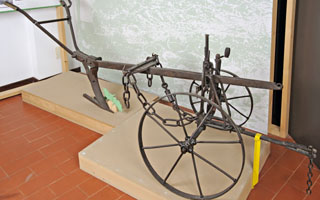Harvest

In early August, farmers began digging sugar beets out of the soil (cavèr al biétol). This continued through the end of September. It was important that the beet be removed unscathed, as any cut could diminish its sugar content. The men were responsible for digging up the beets. The women followed, handling the cleaning and removal of roots and leaves. They wore large handkerchiefs to shield themselves from the sun, along with special handsewn wraps (mangdata) to protect their hands and arms from allergic reactions to the plants. As soon as the sugar beets were removed from the ground, they were scrubbed clean of remaining soil, either by hand or with old brushes. Once cleansed of their roots, a sickle was used to chop off the necks, that is, the portion of the plant with leaves that rested above ground.
After technical innovations during the post-war period, mechanized harvesting methods were adopted using machines (cantìr) that could simultaneously remove beets from the ground, chop off the necks and load them on the pile.
From field to factory
Animal-drawn wagons were used to transport the sugar beets from the fields to the closest production facility (zucherifézzi), or, in the case of more distant factories, the nearest train station, were the beets were loaded into railcars.
Once the sugar beets arrived at destination, the workers would take a sample of the product to determine its weight and quality, the two factors that determined the farmer’s compensation.
The leaves and discarded necks of the sugar beets were used for cattle feed.